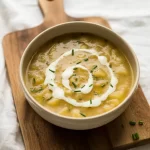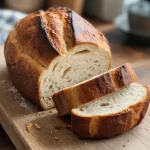This recipe is my go-to because there’s nothing more satisfying than the aroma of fresh-baked bread filling my kitchen and the joy of slicing into a perfect golden loaf that I’ve made from scratch. Plus, the process is this amazing blend of science and art—watching the dough rise is practically magical, and kneading is so therapeutic, it’s like a mini yoga session!

I adore the straightforwardness and sophistication of Classic Pain De Mie. With 3 1/2 cups of all-purpose flour, 1 tablespoon of sugar, and a slight amount of butter, this bread is flexible and just right for sandwiches.
Warm milk and instant yeast form a soft, lovely crumb.
Ingredients

All-purpose flour:
Supplies the bread’s structure; abundant in carbohydrates.
Granulated sugar:
Contributes a touch of sweetness and helps ensure yeast is activated.
Salt:
Improves taste; regulates yeast function for appropriate leavening.
Instant yeast:
Yeast:
Causes the bread to rise; ensures a soft, airy texture.
Warm milk:
Imparts wetness; aids in yielding a tender crumb.
Unsalted butter:
Gives depth; imparts a creamy, buttery flavor.
Ingredient Quantities
- 3 1/2 cups (420g) all-purpose flour
- 1 tablespoon (12g) granulated sugar
- 2 teaspoons (8g) salt
- 2 1/4 teaspoons (7g) instant yeast
- 1 1/4 cups (300ml) warm milk
- 2 tablespoons (28g) unsalted butter, softened
Instructions
1. In a large mixing bowl, blend the flour, sugar, salt, and yeast.
2. Warm milk should be added to the dry ingredients gradually, while mixing, until a rough dough forms.
3. Add the butter (softened) and knead the dough (in the bowl) until it becomes smooth and elastic, about 8-10 minutes.
4. Make a ball with the dough and put it in a bowl that has been greased. Cover the bowl with a clean towel. Let the dough rise in a warm area until it has doubled and is nice and fluffy, which should take about 1 to 2 hours.
5. Once it has risen, gently deflate the dough and turn it out onto a surface that has been lightly floured.
6. Form the dough into a log that will suit a greased loaf pan measuring 9×5 inches.
7. Put the dough in the pan with the seam side down. Cover it with plastic wrap that has been greased. Let the dough rise until it has risen about 1 inch above the top of the pan, which should take about 1 hour.
8. At the last 15 minutes of the dough’s rising time, set your oven to 350°F (175°C) to preheat.
9. Place the bread in the preheated oven and bake for 35-40 minutes, or until the top is a rich golden brown and the loaf makes a hollow sound when you tap it.
10. Take the loaf out of the oven; let it cool in the pan for 10 minutes. Turn the loaf out onto a wire rack. Allow it to cool completely before slicing.
Equipment Needed
1. Large mixing bowl
2. Measuring cups and spoons
3. Spoon or spatula for mixing
4. Towel
5. Loaf pan (9×5 inches)
6. Plastic wrap
7. Oven
8. Wire rack
9. Greased bowl
10. Clean towel
11. Flat surface for kneading and shaping dough
FAQ
- Can I use active dry yeast instead of instant yeast?You can use active dry yeast in place of instant yeast. Just mix the warm milk with the active dry yeast before adding it to the other ingredients, and let it rest for 5-10 minutes until you see some foam.
- Can I make this recipe with whole wheat flour?Certainly! Substituting whole wheat flour for all-purpose flour in bread recipes is an option, and it’s one that many bakers use to make their bread more healthful. It does change the taste, color, and texture of the finished loaf compared to 100% white bread. Whole wheat bread has a heartier flavor and is more filling than white bread. Even just substituting half the all-purpose flour for whole wheat flour will yield a denser, nuttier loaf compared to using only all-purpose flour.
- What kind of pan should I use for baking Pain de Mie?Traditionally, Pain de Mie is baked in a Pullman loaf pan, a common style used for baking bread with a lid. This results in a loaf that is perfectly square all around. However, it is also possible to bake this bread in a normal loaf pan without a lid.
- How do I know when the dough has risen enough?The size of the dough should increase twofold. This normally occurs in the span of 1 to 2 hours, depending on how warm or cool your kitchen is. Indent the dough very gently with a finger; if the dough doesn’t spring back, it was meant to be doubled—size-wise, that is.
- Can I use a stand mixer for kneading the dough?Undoubtedly, a stand mixer with a dough hook attachment is capable of mixing and kneading dough. While it is not a necessary tool for mixing and kneading dough, it can make the process easier and less labor-intensive.
- Is it possible to make this bread dairy-free?Certainly, replace the milk with a dairy-free alternative like almond or soy milk, and use a vegan butter substitute.
- What should I do if my bread crust is too hard?To obtain a softer crust, immediately after baking, brush the loaf with melted butter, then let it cool under a clean kitchen towel.
Substitutions and Variations
Substitute 3 1/2 cups (435g) of bread flour for a chewy texture.
Sweeteners: Alternatively, use 1 tablespoon (12g) honey or maple syrup for a hint of flavor variation.
For a dairy-free version, use 1 1/4 cups (300ml) of almond milk or another plant-based milk.
Butter: For a different flavor, substitute with 28g (2 tablespoons) of coconut oil or olive oil.
Pro Tips
1. Check Milk Temperature: Ensure the warm milk is at about 100°F to 110°F (37°C to 43°C) before adding it to the dry ingredients. This temperature range is ideal for activating the yeast without killing it.
2. Butter Incorporation: Make sure the butter is fully softened to room temperature before adding it to the dough. This will help it integrate smoothly, resulting in a more tender crumb.
3. Kneading Technique: When kneading the dough, resist the urge to add extra flour unless absolutely necessary. A slightly sticky dough is better for achieving a soft and fluffy bread texture.
4. Second Rise Clue: For the second rise, keep an eye on the dough to ensure it rises just about 1 inch above the pan. Over-proofing can lead to a collapsed loaf, so timing is key.
5. Cooling Tip: Allow the bread to cool completely on a wire rack to prevent sogginess. This helps the crust stay crisp and the interior set properly before slicing.

Classic Pain De Mie Recipe
My favorite Classic Pain De Mie Recipe
Equipment Needed:
1. Large mixing bowl
2. Measuring cups and spoons
3. Spoon or spatula for mixing
4. Towel
5. Loaf pan (9×5 inches)
6. Plastic wrap
7. Oven
8. Wire rack
9. Greased bowl
10. Clean towel
11. Flat surface for kneading and shaping dough
Ingredients:
- 3 1/2 cups (420g) all-purpose flour
- 1 tablespoon (12g) granulated sugar
- 2 teaspoons (8g) salt
- 2 1/4 teaspoons (7g) instant yeast
- 1 1/4 cups (300ml) warm milk
- 2 tablespoons (28g) unsalted butter, softened
Instructions:
1. In a large mixing bowl, blend the flour, sugar, salt, and yeast.
2. Warm milk should be added to the dry ingredients gradually, while mixing, until a rough dough forms.
3. Add the butter (softened) and knead the dough (in the bowl) until it becomes smooth and elastic, about 8-10 minutes.
4. Make a ball with the dough and put it in a bowl that has been greased. Cover the bowl with a clean towel. Let the dough rise in a warm area until it has doubled and is nice and fluffy, which should take about 1 to 2 hours.
5. Once it has risen, gently deflate the dough and turn it out onto a surface that has been lightly floured.
6. Form the dough into a log that will suit a greased loaf pan measuring 9×5 inches.
7. Put the dough in the pan with the seam side down. Cover it with plastic wrap that has been greased. Let the dough rise until it has risen about 1 inch above the top of the pan, which should take about 1 hour.
8. At the last 15 minutes of the dough’s rising time, set your oven to 350°F (175°C) to preheat.
9. Place the bread in the preheated oven and bake for 35-40 minutes, or until the top is a rich golden brown and the loaf makes a hollow sound when you tap it.
10. Take the loaf out of the oven; let it cool in the pan for 10 minutes. Turn the loaf out onto a wire rack. Allow it to cool completely before slicing.
















